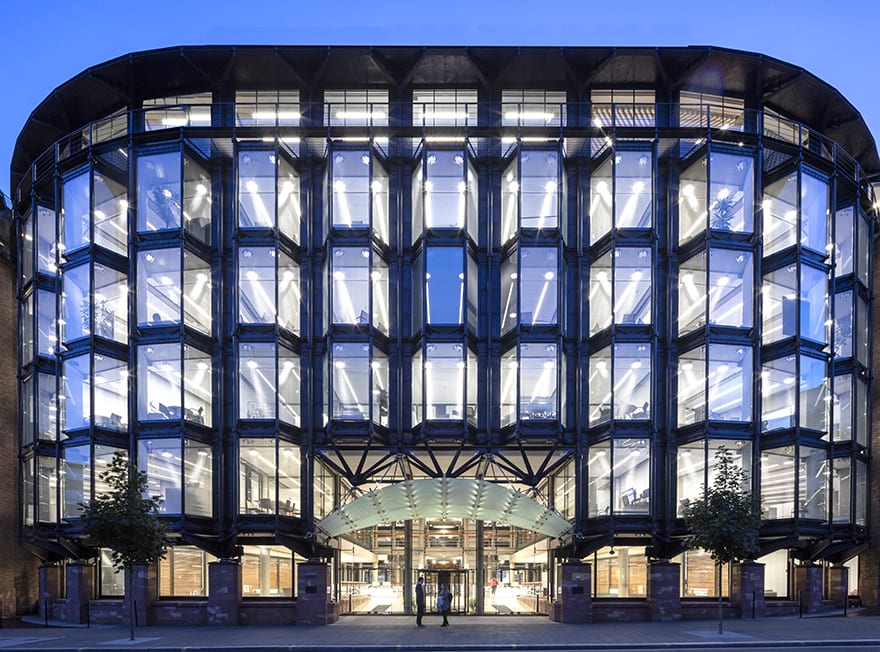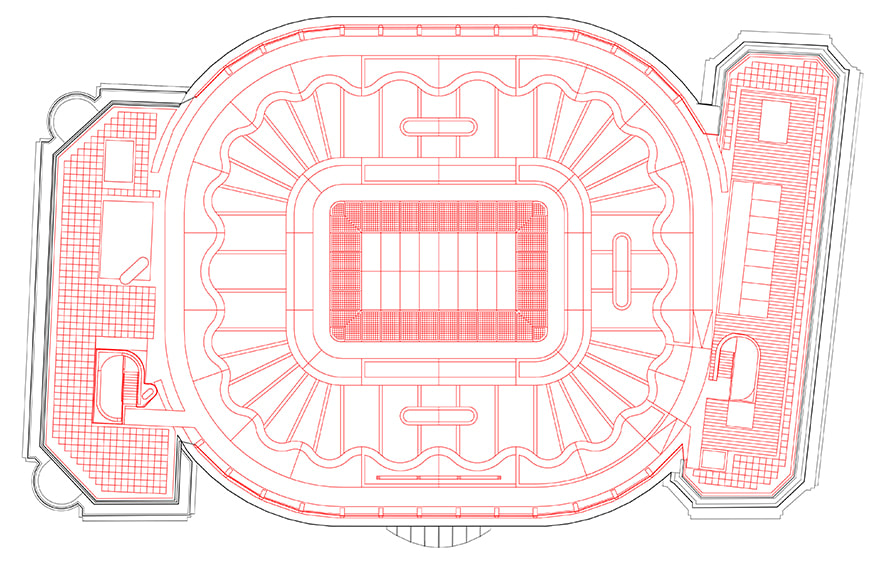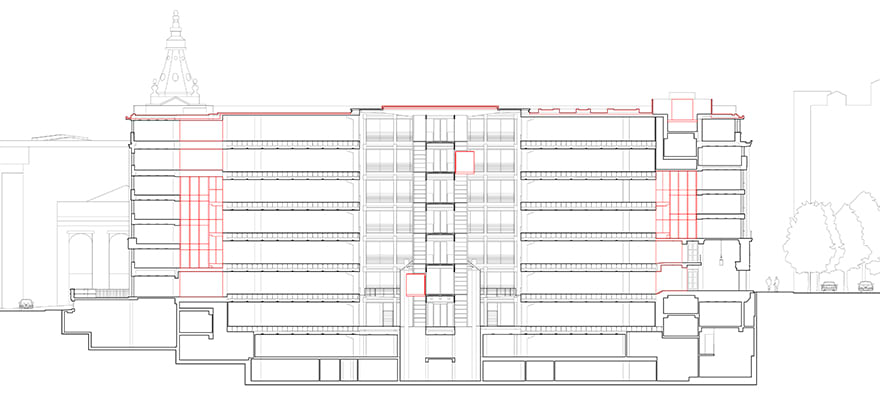- Client: Financial Times
- Lead Contractor: Arup, Architect: JRA
- BIM Tools: ArchiCAD, Solibri, ArchiCAD renovation tool
Hailed as an important example of 20th century architecture and Grade II* listed, Bracken House tells a story of changing architectural styles and showcases how a BIM-enabled 21st century restoration can breathe new life into an ageing landmark building.
John Robertson Architects (JRA) was tasked with refurbishing the building, sensitively enhancing the two previous architects’ designs, while upgrading the facilities for the next generation of tenants. Now complete, the retrofit has made it possible for the FT to return to the iconic building, following a 30-year absence.
Double listed status
Situated in the heart of the City of London, within sight of St Paul’s Cathedral, Bracken House was built by Sir Albert Richardson in 1959 as the Financial Times’ headquarters and printworks. But by the mid-1980s it needed refurbishment. The FT moved out and the building was sold to Obayashi Corporation. Due to be demolished and replaced, the building was spot-listed in 1987, making Bracken House the first post-war building in England to be given listed status.
Following the listing, architect Michael Hopkins went back to the drawing board and subsequently it was agreed to demolish and replace the central part of the building that had housed the printworks, retaining the two pink sandstone wings. Hopkins slotted a fashionable 1980s glass and steel block between the two wings and in 2013, the building was Grade II* listed, this time including the Hopkins work.
A 21st century brief
JRA’s brief was to bring the building up to current standards, working closely with structural and building services engineer Arup to overhaul the services, including the mechanical ventilation and plant located in the building’s basement, and to modernise the building in terms of energy use, light and space requirements.
JRA’s transformation included a complete overhaul of the office accommodation after a quarter of a century of use. The office floors have been upgraded to meet future City of London occupier standards, and to provide for higher building occupancy levels. The office areas now have state-of-the-art LED lighting and energy efficient air conditioning systems.

Bracken House was built by Sir Albert Richardson in 1959 as the Financial Times’ headquarters and printworks
Part of architect Hopkins’ original plan for the building was to include a roof terrace, or “fifth elevation”. A key element of JRA’s client brief was to create this outdoor space, which is increasingly valuable for offices in modern day London.
However, it was not a simple task to add the roof terrace on a listed building within sight of St Paul’s Cathedral. JRA’s proposals had to conform with the constraints imposed by the St Paul’s Heights Grid, (a City of London Corporation policy designed to protect and enhance important views of the cathedral), while also gaining approval and support from the City of London (planning permission), Heritage England (listed building consent), Surveyor to the Fabric of St Paul’s (view from the Golden Gallery of St Paul’s) and the Twentieth Century Society (works to an iconic 20th century building).
This process involved extensive consultation and numerous presentations, even before engaging with the technical delivery of the ideas, which presented its own construction challenges.
“We had to keep everything on the roof terrace very low as we weren’t allowed to add any additional height,” explains Zemien Lee, project director at JRA. “It was important to consider every millimetre, so we needed to use very compact planting.”
“Not only were we restricted on height, but also on weight. We were limited on what loading we could add to the roof. Therefore, all hard landscaping needed to be made from very lightweight materials.”
The end result is a large roof terrace, which features a landscaped garden, seating and a running track, as well as 360-degree views across the City of London
A seamless transition
One of the main interventions was to join the central atrium to the two wings which were previously isolated from the rest of the building. JRA’s solution was to create an enlarged entrance hall and two internal courtyards. These courtyards also required detailed approvals and consents from the City of London Corporation.
In addition, the structural design and architectural detailing were challenging, as the original building included multiple level changes and different forms of construction. The result was to neatly join the two architectures together and unify what had been two very separate and disconnected office spaces.

A key element of JRA’s client brief was to create a roof terrace
New designs for the atrium roof have markedly increased the amount of daylight reaching the central atrium.
Lee explains: “The glass block atrium roof was one of the main features of the original building. We went through multiple options of how to bring more light into the building. We modelled each iteration in ArchiCAD and handed the details over to Arup, which carried out detailed sun studies.
“After consultation with Historic England, we decided to remove and replace central parts of the atrium roof with clear glazing, while retaining the original ‘Glasscrete’ around the perimeter. As a result, we’ve increased the amount of natural light in the atrium by 150%.”
The client was keen to use BIM from the outset, both during the refurbishment and afterwards for facilities management. Bracken House was the first refurbishment project that JRA had carried out to BIM Level 2 and at 26,000m2, the project was a significant size.
Understanding how best to engage with the existing building, with its many quirks and dimensional restrictions and to then translate that into a BIM model, presented a significant challenge for the team.
The power of a point cloud survey
In this case the challenge was overcome by carrying out both pre-strip-out and post-strip-out point cloud surveys.
The first point cloud survey was used to inform the initial 3D model of the existing building, which was created in ArchiCAD. Thereafter, existing 3D elements were retained, adapted or removed using ArchiCAD’s renovation tool.
“The renovation tool was brilliant. Following the original survey, we used the tool to switch off everything that was going to be demolished,” explains Sonia Brims, architect at JRA.
“It was really useful to bring the point cloud survey directly into ArchiCAD. The initial point cloud survey was completed while the previous tenants were still in situ, but once they had moved out, Obayashi appointed Plowman Craven to do a new survey to cover more of the building.”
Modelling a complex, listed building
From the outset, the BIM model provided JRA with a visual tool to aid communication with the client and the wider project team. Initially, this was valuable to help communicate with the multiple interested parties and to subsequently gain planning permission.
Lee says: “During the design stage, ArchiCAD helped us to clearly present our design proposals to the client.”

One of the main interventions was to join the central atrium to the two wings which were previously isolated from the rest of the building
Post-planning, the BIM model was invaluable in aiding communication between the structural and MEP engineer, main contractor and subcontractors, and between CAT A and CAT B architectural teams.
Brims explains: “We exchanged information with the MEP engineers, structural engineers and contractors via IFC, and used Solibri to create the federated model. Following the BIM Level 2 process we had meetings once a week to look at clash detection. This significantly reduced the number of clashes we had to contend with on site.”
“ArchiCAD helped us to create our design and make changes to it much more quickly. With design elements, the design process is so much faster as you don’t have to model everything from scratch on every occasion,” continues Brims.
“In addition, ArchiCAD’s scheduling tool meant we could produce 2D and 3D schedules very quickly. We produced the areas schedule, door schedule and window schedule using this function. We also used schedules to check that we had had met the Employer’s Information Requirements (EIR) and in the post-construction phase for snagging.”
On-site collaboration
JRA was heavily involved throughout the construction stage of the project. As part of the refurbishment, main contractor McLaren removed the old plant from the basement and replaced it with modern, energy efficient machinery.
“This was a challenging process as the existing plant had been absolutely packed into the basement,” says Brims. “The dimensional information in ArchiCAD enabled us to model what was already there, and helped us to look at different scenarios to remove the existing plant. In some cases, we needed to take down walls to take something out.”
Brims continues: “While onsite, with ArchiCAD, we could mark data directly onto the plan. There was no need to create an extra set of schedules as the contractor could instantly find what they were looking for. This saved considerable time. The BIM model was so useful to aid communication. If we wanted to pinpoint where something was onsite, we could easily do that.”
“At the snagging and inspection stage, the search function within ArchiCAD was invaluable. For example, there were 600 doors in the building. By using the search tool, we could immediately identify where the doors were and quickly see if there was a problem. To do this manually could have taken a few minutes for each door, which with 600 doors would quickly add up.”
With the refurbishment complete, the contractor took the final federated model and COBie information and added more information from the subcontractors. This BIM information will be used for ongoing facilities management, enabling any future repairs and replacements to be carried out more efficiently.
The result of this sensitive refurbishment is a balance between conservation and progression – preserving the qualities of the original Richardson and Hopkins designs but enhancing the building for its modern-day tenants. The building now functions better both spatially and environmentally and has been fully brought up-to-date for 21st century use.
Comments
Comments are closed.
















Proud to have been a Construction Manager on the landmark Michael Hopkins redevelopment at Bracken House working for Trollope & Colls Construction the Main Contractor and chuffed to see this element is now part of the Grade II* listing.
Dave Ashton MCIOB
I’m proud to have been part of this project from a MEP perspective and to have works with a great design team. There were over 5000 MEP elements with all COBie data, QR tagged and linked back to the IFC models.
Congratulations to the whole project delivery team.